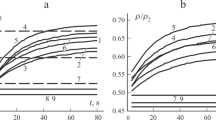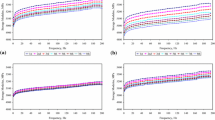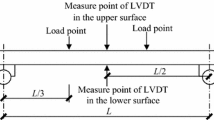Summary
The mechanical behaviour of three species of hardwoods, soaked in different liquids, had been investigated at high rates of strain using a Hopkinson pressure bar system. In order to determine the influence of the rate of strain, samples from the same species were subjected to compression-tests at low rates of strain. It was noticed that, at low rates of strain, the saturated samples were always less stiff than the dry ones, which is in agreement with the literature, but differs from the behaviour at high rates of strain. This difference is attributed to the behaviour of the liquid present in the large cavities of the material, which must depend on the rate of strain. It was also noticed that the samples could support higher stresses at high rates of strain. Although permanent sets were measured after the tests, the samples were not always visibly damaged, but some typical failures were detected by means of microscopy. The damaged zones presented similar aspects, whatever the rate of strain.
Similar content being viewed by others
References
Bariska, M.; Kucera, L. J. 1985: On the fracture morphology in wood. Part 2: macroscopical deformations upon ultimate axial compression in wood. Wood Sci. Technol. 19: 19–34
Bienfait, J. L. 1926: Relation of the manner of failure to the structure of wood under compression parallel to the grain. J. Agric. Res. 33: 183–194
Debaise, G. R.; Porter, A. W.; Pentoney, R. E. 1966: Morphological and mechanics of wood fracture. Materials Research and Standards 6: 10: 493–499
Green, H. V. 1962: Compression caused transverse discontinuities in tracheids. Pulp and Pap. Can. 62: 3: 155–168
Kollmann, F.; Cote, W. A. Jr 1968: Principles of wood science and technology I: Solid Wood. Springer Verlag
Renaud, M.; Rueff, M.; Rocaboy, A. C. 1996: Mechanical behaviour of saturated wood under compression, Part I: Behaviour of wood at high rates of strain. Wood Sci. Technol. 30: 153–164
Robinson, W. 1920: The microscopical features of mechanical strains in timber and the bearing of these on the structure of the cell wall in plants. Phil. Trans. R. Soc. London B 210: 49–82
Wardrop, A. B.; Dadswell, H. E. 1947: Contributions to the study of the cell wall. The occurence, structure and properties of certain cell wall deformations. Commonwealth of Australia. C.I.S.R. bull. no. 221.
French standard NF B 51007: Bois Essai de compression axiale (September 1985)
Author information
Authors and Affiliations
Rights and permissions
About this article
Cite this article
Renaud, M., Rueff, M. & Rocaboy, A.C. Mechanical behaviour of saturated wood under compression Part 2: Behaviour of wood at low rates of strain some effects of compression on wood structure. Wood Sci.Technol. 30, 237–243 (1996). https://doi.org/10.1007/BF00229346
Received:
Issue Date:
DOI: https://doi.org/10.1007/BF00229346




